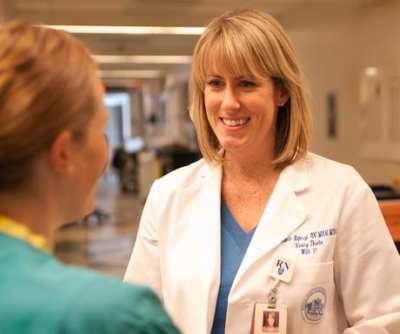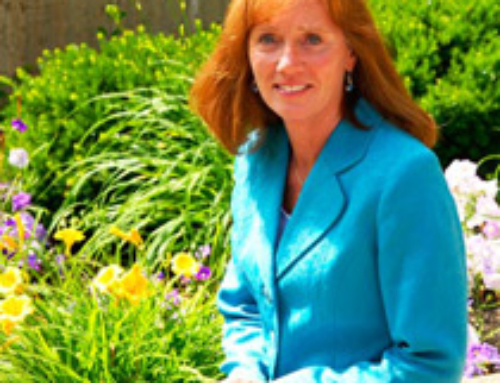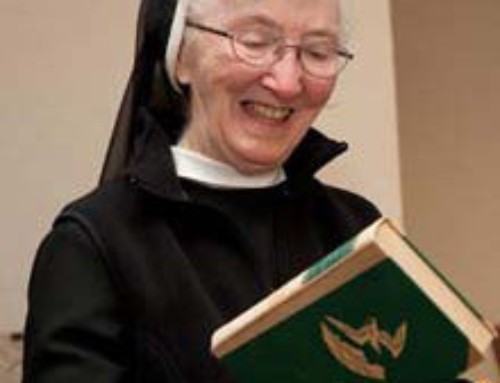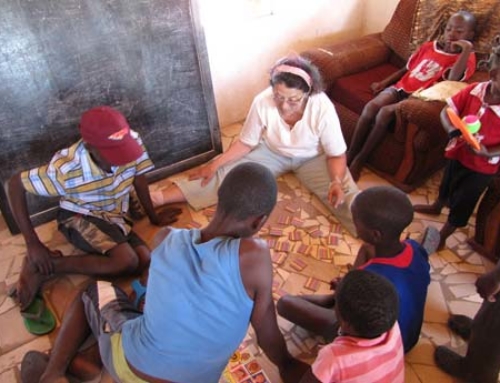 How one alumna at a major urban hospital piloted a national program that changed the culture for nurses and patients on her unit.
How one alumna at a major urban hospital piloted a national program that changed the culture for nurses and patients on her unit.
Inside a hospital, medical care never stops. For nurses working a 12-hour shift, a good time to take a real lunch break never comes… or does it? In 2007, one unit at Massachusetts General Hospital supervised by Amanda Stefancyk ’98 took a closer look at the question. Stefancyk observes, “The nurses were constantly running and rarely paused to take a break away from the stresses of the job to recharge.” A proper meal break, while supported administratively, usually took the form of a quickly eaten lunch in the staff lounge. But that has changed now, thanks to Stefancyk’s involvement with a national initiative called Transforming Care at the Bedside (TCAB). Today, all the nurses on her floor take time to have an uninterrupted lunch away from the unit.
Taking an offsite break from your duties sounds like a simple change, but the nurses on the White 10 unit were initially reluctant. To shift the culture around taking breaks, they had to embrace the change as a unit. When they did, they immediately saw the benefit. Nurses returned to the unit feeling refreshed and ready for the rest of their day. Teamwork improved as nurses handed off patient care activities to each other. And, as the nurses touched base with each patient about any immediate needs and the name of the nurse who would be covering, patients also benefited. When Stefancyk wrote about the unit’s TCAB journey for the American Journal of Nursing, the lunch break article generated a huge amount of e-mail from nurses. They knew that particular change was significant and they wanted to know, “How did you make this happen?”
Stefancyk, 36, acknowledges but downplays her influence in bringing about the changes ushered in through Transforming Care at the Bedside. When the chief nursing officer and associate chief embraced TCAB at Mass General, they selected Stefancyk’s unit to launch it as a pilot program. She signed on with her signature positive attitude, but credits her team with making the ensuing changes work.
“I have a great staff of clinicians and leaders … TCAB being bottom-up in design opened the door for everyone on the unit to get involved,” she says. “Staff at the bedside spend the most time with patients and their families. They know what is working and what isn’t,” she adds.
When the TCAB project kicked off at a retreat in the summer of 2007, the entire White 10 staff – including secretaries and housekeepers – brainstormed for two days on how to improve patient care, efficiency, and teamwork. They came up with more than 500 ideas, from the mundane to the far-reaching. In two years, 33 of those ideas emerged as significant changes. In the medical world, where seconds and minutes count, simply moving high-use supplies into the patient rooms saved approximately 1,200 hours per year searching for supplies. It is time that is now spent with patients.
One of the biggest changes they made was defining a more formal, active role for the nurse in daily nurse/physician rounds. Instead of simply being present at the table, nurses now presented their patients to the team. They were able to give physicians up-to-date information and nuances about their patients. Although this change improved patient care and nurse/physician communication and teamwork, it was not an easy change to make. “The first six months were a challenge…” she says with a smile, “but on two recent occasions I have been approached by physician leaders who are interested in partnering with me to spread this change to other general medical units.”
As Stefancyk steered her unit through the changes, she empowered the staff to run the weekly TCAB meetings themselves. And she encouraged them, even as she nudged them to stay on task. Some of the new changes stood, while others fell by the wayside. What didn’t work was abandoned within a week or two because the TCAB project encouraged “rapid cycle” change to avoid getting bogged down.
In the process, Stefancyk learned to accept a change that didn’t look like what she thought it would. “If it worked for the unit and improved teamwork and efficiency, I had to be flexible. I learned not to manage every piece of the change,” she notes.
Originally from Whitinsville, Mass., Stefancyk now lives in South Boston. After high school, she enrolled in nursing at the University of Massachusetts in Amherst, but transferred to Saint Joseph’s after two years. (Her mother, Denise Stefancyk, had graduated in 1997 from the Saint Joseph’s RN-to-BSN program.) The smaller campus and more individual attention suited her. “The best move I made was to transfer …. I left well prepared to be a nursing leader,” she says of her experience at Saint Joseph’s.
After working as a nurse in Worcester, she worked for six years in Baltimore at Johns Hopkins Hospital, while simultaneously earning her MBA and MSN at Johns Hopkins University. She’s been at Mass General for almost five years now, all of them on White 10.
Stefancyk has emerged as a nursing leader at the national level. In 2008, she was chosen as one of 30 nurse managers for the American Organization of Nurse Executives’ inaugural Nurse Manager Fellowship class and published a year-long, monthly column in the American Journal of Nursing. Stefancyk has subsequently been asked to speak at hospitals new to TCAB and to be a faculty mentor for the Aligning Forces for Quality initiative, also funded through the Robert Wood Johnson Foundation. She has also been a keynote speaker at local and national conferences.
For all that she has accomplished, public speaking may have been the biggest challenge she has had to overcome. “Early on in our hospital’s involvement with TCAB, my chief nurse knew I would be doing a lot of public speaking and that it made me uncomfortable. She offered the support of an executive coach, which was very helpful.” With her new skills, Stefancyk reluctantly accepted every opportunity to practice. “I still get nervous,” she says, “but once I get through the first two minutes, I’m fine.”
After 2½ years of TCAB research data and continuing trials of many protocols, the results on White 10 are promising. “With TCAB, patient care improved not because of one change, but rather the collection of changes,” says Stefancyk. “Many patient quality and safety measures improved as well as staff satisfaction. Data collected from our time and motion studies showed a 10 percentage point increase in direct care activities, meaning nurses are now spending more time doing nursing work.”
Though Stefancyk shines in her administrative role, her devotion to patients and staff comes first.
“I like seeing the staff reach their full potential, and some are vocal about how I’ve affected their career for the better,” she says.
Stefancyk describes her job as “incredibly challenging but so rewarding,” in part because of her unit’s teamwork to provide excellent patient care.
The nurses on her floor consistently meet challenges, while managing the medical complexity of their patients and the rapid pace at which their condition can change. Reassessment and updating of a care plan are constant. “Caring for an acutely ill patient during their hospitalization and getting them home is no small task,” she says. “It requires a ton of work, expertise, and the ability to collaborate with other disciplines such as physicians, physical therapy, pharmacology, social work, nutrition and clinical skills.”
“TCAB,” she says, “was about how the culture changed and how nurses understood they are empowered and can … take the lead on the unit. As the staff took on more responsibility as a team, patient care improved,” she notes. The nurses on White 10 are lucky to have a genuine, collaborative manager who listens to them and cares so deeply about nursing.
And, at last, those nurses do take a real lunch break.
by Charmaine Daniels
Transforming Care at the Bedside
A national project called Transforming Care at the Bedside (TCAB) started in 2003 with funding from the Robert Wood Johnson Foundation. Recognizing that medical-surgical units are among the busiest and most challenging areas of many hospitals, the foundation sought to find ways to retain bedside nurses by empowering them to make the changes needed to improve care and teamwork on the unit. The Institute for Healthcare Improvement led the first phase of this work with 10 hospitals that had agreed to test a new role for nurses and other team members who are on the front line of care.
TCAB focuses on making improvements in four areas: the safety and reliability of patient care; team vitality and teamwork; patient- and family-centered care; adding value to care processes (for example, by increasing the time that nurses spend in direct contact with patients).
These aims are achieved by providing frontline staff with the authority and tools needed to make such changes. For example, staff members engage in brainstorming exercises called “snorkels” and “deep dives” to identify barriers and possible solutions. Using the plan–do–study–act, or PDSA, method, staff members test, evaluate, and tweak their ideas as needed and then spread their use.
Taking off from the success of the initial 10 hospitals, the American Organization of Nurse Executives is leading a second phase of TCAB that involves more than 60 hospitals. Additional TCAB initiatives are expected from the Robert Wood Johnson Foundation.



